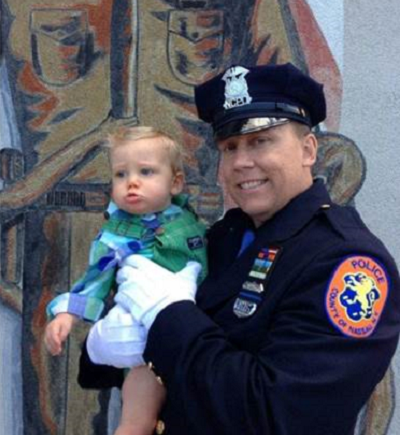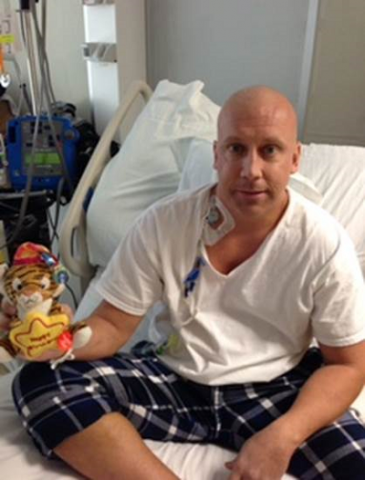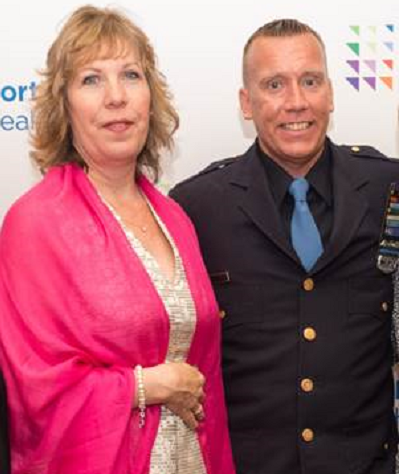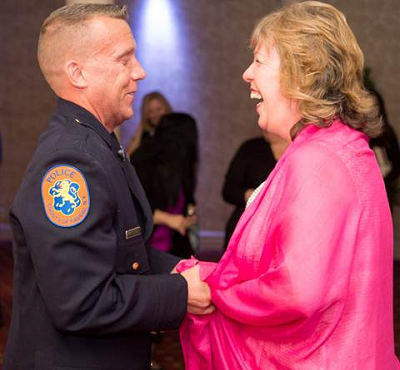'She's my hero'
A New York Police Officer who was diagnosed with leukaemia which doctors believe was brought on by his efforts on September 11th has met the transatlantic stem cell donor who saved his life.
Greg Holgerson met Sue Harrison last night on stage at a fundraising gala for the Don Monti Memorial Research Foundation at North Shore University Hospital, New York, where he received treatment for his cancer, two years after she saved his life.

After a worldwide search of donor registers, Sue was found to be a perfect match for Greg in 2014 when he was told it was his best hope of survival.
Anonymity rules mean that transplant donors and recipients can’t reveal their identities to each other for two years, but can exchange letters through blood cancer charity Anthony Nolan. Nevertheless, Greg often wondered about the stranger who had selflessly donated to save his life.
Holgerson said, ‘It was an unbelievable moment to finally meet Sue in person and give her a big hug – she’s my hero. It’s impossible to find the words to sum up what she has done for me and family; ‘thank you’ just doesn’t seem enough. Put simply, if it wasn’t for her I might not be here today.
‘I feel lucky to have a donor but I’m even more fortunate to have Sue because she is so lovely. It’s been amazing to share our different sides of the story and to show her the impact her donation has had. She feels like part of the family now!’

Greg's story
Holgerson, 42, who was only a year and a half into his job as a Police Officer, was off work on September 11th but when the attacks happened he was called in with his fellow officers.
‘We watched it on TV and when the second plane hit we knew something really wasn’t right and it might be an attack. It was scary- you had the two planes but you didn’t know if there were going to be more.
‘About 5pm they sent us over to relieve the guys who were there. We saw all the terrible destruction but we had to secure the area and help with the recovery in any way we could.
‘Everyone there was covered in dust and debris. It looked like it was snowing, it was just surreal. I was born and raised in New York and it was heart-breaking to see. There were so many innocent lives taken.’
It was 12 years later in 2012, whilst Greg was working for the Nassau County Police force, that he started to feel unwell and received a shocking blood cancer diagnosis that doctors believed could be linked to his time serving as an officer during 9/11.
‘It was just a few weeks after my son was born. I was playing softball and I was a little tired but I thought it was because of work and having a new-born. I went to play golf with my dad the next day but I still didn’t feel right. I didn’t want to bother my wife because of our baby so I got my dad to take me to the hospital. They checked me over, did some tests and they told me my bloods were way off.
‘When I was told it was leukaemia I was devastated. I had two small children and I was only 39 years old. It was all new to me and you think the worst,’ said Greg.
‘As someone who was involved in 9/11, I heard there was a lot of people getting sick but it didn’t really cross my mind that it might happen to me or why I was sick. When I first went into the hospital they knew I was a police officer and they asked me if was I down at the World Trade Center on the day and the following days and they told me about the link between the two. You see more and more people that were down there getting sick - it’s not a coincidence.’

Greg then underwent several courses of chemotherapy and went into remission in the summer of 2012. Sadly a routine test in the summer of 2013 later revealed his cancer had returned and his best hope was a stem cell donor.
‘When they told me my cancer had returned it was almost more devastating than the initial diagnosis. I thought it was behind me and I’d just got back to work, but I didn’t have a choice. I had to fight on for my family. It was tough being away from them - we didn’t tell the kids what was going on - we just told them that ‘daddy was at work or at training.’
Sue's story
Thankfully, Sue Harrison, 52, from Northampton, signed up to the Anthony Nolan register in the 80s when she was in her early twenties. Donors can sign up to the register between the ages of 16–30 but stay on the register until they are 60.
‘I signed up after I met my husband Robert, who lost his mother to leukaemia sadly when there wasn’t a register around to help. I just thought why not? It didn’t involve too much effort from me and it seemed like a worthwhile thing to do. I put my card in the drawer and just completely forgot about it.
“It was a real shock to hear I was a match so many years later. I was surprised by how few people actually get a match so it was very special.”
“It was very emotional to meet Greg, I can’t imagine what he’s seen and been through it just seems so unfair that he got his cancer through helping others.
‘He often says he can’t thank me enough but seeing his family together and knowing those children will be able to grow up with their dad, his wife with a husband is thanks enough for me.’

Now both Greg and Sue are calling on more people to sign up to the Anthony Nolan register.
Sue says, ‘There is definitely a stigma around donating. Many people think it’s a painful or invasive procedure - my mum was worried sick, but that’s what mums do! At no time was it painful, it was so easy and I would have done it again all again. Afterwards I had a cup of tea and headed home.’
